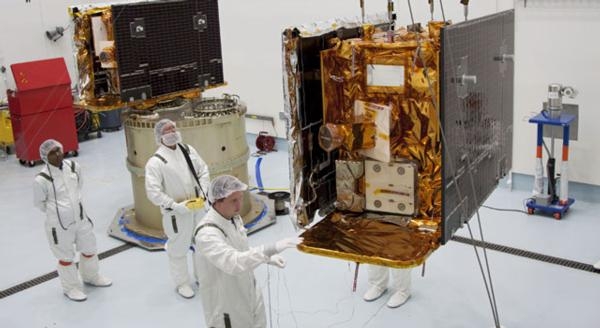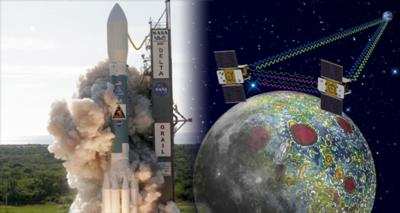Sun, Jan 01, 2012
First of NASA's GRAIL Spacecraft Starts Orbit
NASA has confirmed that the first of two NASA spacecraft to
study the moon in unprecedented detail has entered lunar orbit.
NASA's Gravity Recovery And Interior Laboratory (GRAIL)-A
spacecraft successfully completed its planned main engine burn at 2
p.m. PST (5 p.m. EST) today. As of 3 p.m. PST (6 p.m. EST), GRAIL-A
is in an orbit of 56 miles by 5,197 miles around the moon that
takes approximately 11.5 hours to complete.

"My resolution for the new year is to unlock lunar mysteries and
understand how the moon, Earth and other rocky planets evolved,"
said Maria Zuber, GRAIL principal investigator at the Massachusetts
Institute of Technology in Cambridge. "Now, with GRAIL-A
successfully placed in orbit around the moon, we are one step
closer to achieving that goal."
The next mission milestone occurs tomorrow when GRAIL-A's mirror
twin, GRAIL-B, performs its own main engine burn to place it in
lunar orbit. At 3 p.m. PST (6 p.m. EST) today, GRAIL-B was 30,018
miles from the moon and closing at a rate of 896 mph. GRAIL-B's
insertion burn is scheduled to begin tomorrow, Jan. 1, at 2:05 p.m.
PST (5:05 p.m. EST) and will last about 39 minutes.
"With GRAIL-A in lunar orbit we are halfway home," said David
Lehman, GRAIL project manager at NASA's Jet Propulsion Laboratory
in Pasadena, Calif. "Tomorrow may be New Year's everywhere else,
but it's another work day around the moon and here at JPL for the
GRAIL team."

Once both spacecraft are confirmed in orbit and operating,
science work will begin in March. The spacecraft will transmit
radio signals precisely defining the distance between them as they
orbit the moon in formation. As they fly over areas of greater and
lesser gravity caused by both visible features, such as mountains
and craters, and masses hidden beneath the lunar surface, the
distance between the two spacecraft will change slightly.
Scientists will translate this information into a high-resolution
map of the moon's gravitational field. The data will allow
scientists to understand what goes on below the lunar surface. This
information will increase knowledge of how Earth and its rocky
neighbors in the inner solar system developed into the diverse
worlds we see today.
JPL manages the GRAIL mission for NASA's Science Mission
Directorate at the agency's headquarters in Washington. The GRAIL
mission is part of the Discovery Program managed at NASA's Marshall
Space Flight Center in Huntsville, Ala. Lockheed Martin Space
Systems in Denver built the spacecraft.
More News
He Attempted To Restart The Engine Three Times. On The Third Restart Attempt, He Noticed That Flames Were Coming Out From The Right Wing Near The Fuel Cap Analysis: The pilot repor>[...]
Make Sure You NEVER Miss A New Story From Aero-News Network Do you ever feel like you never see posts from a certain person or page on Facebook or Instagram? Here’s how you c>[...]
From 2009 (YouTube Edition): Leading Air Show Performers Give Their Best Advice for Newcomers On December 6th through December 9th, the Paris Las Vegas Hotel hosted over 1,500 air >[...]
Aero Linx: NASA ASRS ASRS captures confidential reports, analyzes the resulting aviation safety data, and disseminates vital information to the aviation community. The ASRS is an i>[...]
“For our inaugural Pylon Racing Seminar in Roswell, we were thrilled to certify 60 pilots across our six closed-course pylon race classes. Not only did this year’s PRS >[...]
 NTSB Final Report: Rutan Long-EZ
NTSB Final Report: Rutan Long-EZ ANN FAQ: Turn On Post Notifications
ANN FAQ: Turn On Post Notifications Classic Aero-TV: ICAS Perspectives - Advice for New Air Show Performers
Classic Aero-TV: ICAS Perspectives - Advice for New Air Show Performers ANN's Daily Aero-Linx (06.28.25)
ANN's Daily Aero-Linx (06.28.25) Aero-News: Quote of the Day (06.28.25)
Aero-News: Quote of the Day (06.28.25)




